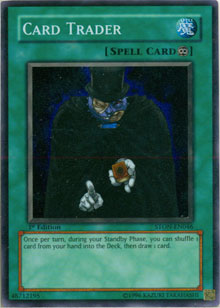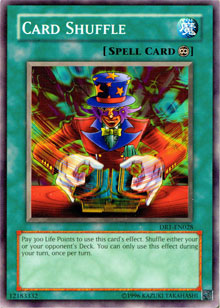Well, my Round 9 feature match got destroyed by some technical difficulties, so sadly you won’t get to read about Jerry Wang’s masterful 2-0 victory over up-and-comer Austin Blair. However, this does seem like a great opportunity to look at one of the biggest new factors here at today’s Shonen Jump Championships.
A few recent changes to the tournament policies resulted in some new conditions here in Orlando, and they’ve definitely caused some subtle changes to the tournament environment. The two major changes are pretty easy to understand on a surface level, but lots of duelists aren’t aware of them, or the full extent of their impact on the game. Few to no duelists are actually taking full advantage of the new policies, but that will change as people become familiar with them. Let’s take a quick look.
Note Taking Now Allowed
Previously, the only notes a player was allowed to take during a match were those related to life point information — it was legal to write something like “1000 — Sangan,” but they weren’t allowed to write anything else. Now, you can write virtually anything you want on a per-game basis, provided your notes don’t violate sportsmanlike conduct.
 You also can’t delay gameplay whatsoever to take notes — today in Orlando, players who activated Trap Dustshoot were allowed to look at their opponent’s hand, see the contents, and then write down the hand after the hand had been concealed again. No one looking to use the new protocol in order to stall matches and play the clock will be permitted to do so.
You also can’t delay gameplay whatsoever to take notes — today in Orlando, players who activated Trap Dustshoot were allowed to look at their opponent’s hand, see the contents, and then write down the hand after the hand had been concealed again. No one looking to use the new protocol in order to stall matches and play the clock will be permitted to do so.
Note that the lifespan of your notes is “per game” — you aren’t allowed to take notes in game 1 and then refer to them in game 2 or 3, nor can you take notes in one match and then share them with teammates later during the tournament. Doing so will come with extremely hefty penalties. You may, however, keep notes tucked away in your personal belongings for review after the tournament. That’s important because it helps achieve one of the goals of the new policy.
Allowing note taking solves several problems and permits some big advantages. On one hand, some believe it flattens the skill curve between top players and weaker ones. But on the other, a lot of duelists here today felt that the note taking policy let them focus more on actual gameplay and tactics, instead of remembering to get their Treeborn Frog or constantly chanting the contents of the opponent’s revealed hand over and over. This policy will level the playing field for duelists with naturally weaker memories, and will allow more focus for tighter plays.
In addition, since players won’t have to stare at a revealed hand for minutes on end to try and memorize the contents, rounds at premier events should be faster. Having done hundreds of feature matches at this point I can say this is a welcome change; the amount of time wasted and delays created by memory-driven issues is tremendous, but it was a difficult thing for judge staff to police. Now it will be less of a problem.
On top of that, since you can keep your notes for later reference, it’s going to be far easier for message board-going players to create in-depth tournament reports. Instead of having to try and recreate all your matches through life point notation only, you can take detailed notes on your own match for review and public display later on. You can even use your own tournament reports to peg down your mistakes and improve your skills, something that was difficult to do if you had to struggle to remember the nine rounds you just played.
Everybody here today, from players like Adam Corn on down to relative newbies, seemed very happy with the new policy. I was surprised — I expected the duelists with more experience and better “Yu-Gi-Oh! memory” to complain, but that hasn’t been the sentiment at all. The note taking system seems to offer something for all player demographics, and that’s going to make it popular.
However, despite the enthusiasm surrounding the change, virtually no one in feature matches I covered actually took advantage of the new rule. A few duelists, such as Jeff Jones and James Neumann, came to their tables armed and ready with notepads, but in the end there were virtually no notes actually taken. This might change as players acclimate to the new system.
Shuffle-Shuffle-Cut-Cut
This is my personal favorite of the two policy changes. Basically, no matter what you do under the current system, your opponent gets a final cut of your deck. Here are the scenarios that can occur when a deck randomization is called for — both before a game, or during,
 If you shuffle your deck and your opponent cuts it, then you may not take a final cut of your deck.
If you shuffle your deck and your opponent cuts it, then you may not take a final cut of your deck.
If you shuffle your deck and your opponent shuffles it, you must cut it. Then, your opponent must cut it as well.
That’s it — there are no other options. The opponent must randomize your deck in one way or another, and your opponent must always take a final cut. This will usually result in a shuffle-shuffle-cut-cut sequence of events.
This is a little extra work (all of about five seconds’ worth) and it confused a lot of duelists here today simply because it was so new (listen to the player meeting, people!). With that said, by the end of Day 1 most players were broken in, though many didn’t seem to understand the purpose of the additional final cut.
In short, with your opponent making the final cut of your deck it is essentially impossible for you to use any underhanded methods to manipulate your draws. The few players who would be interested in arranging their deck to grant themselves an unfair advantage are shut down by this new policy. In addition, so long as there are no markings on your cards, your opponent should have no idea as to where particular cards in your deck are, and thus won’t be able to cut them to the bottom of your deck. Both players are much more secure.
 The one concern about this system is that an opponent could arrange your deck during their shuffle. Then, when you cut your deck, they could simply cut back. A bereaved, puppy-eyed Dale Bellido approached me with this very issue before round 1 today. The easy answer to this, and the one I gave Dale, is two-fold: when you cut your deck, cut it quickly and randomly. Then, when you place one half of the deck back on top of the other, square it, ensuring that the corners are all in line and there are no tell-tale signs of where you cut. It’s as simple as pressing on your deck at each side, and offers complete security. The answer was good enough for Dale Bellido, so I assume it’ll prove sound for anybody else.
The one concern about this system is that an opponent could arrange your deck during their shuffle. Then, when you cut your deck, they could simply cut back. A bereaved, puppy-eyed Dale Bellido approached me with this very issue before round 1 today. The easy answer to this, and the one I gave Dale, is two-fold: when you cut your deck, cut it quickly and randomly. Then, when you place one half of the deck back on top of the other, square it, ensuring that the corners are all in line and there are no tell-tale signs of where you cut. It’s as simple as pressing on your deck at each side, and offers complete security. The answer was good enough for Dale Bellido, so I assume it’ll prove sound for anybody else.
As long as you understand these new policies, they can work really easily to keep your mind on the game at hand and to keep the integrity of the game secure. Take full advantage of them — buy a notebook and a couple pens and be ready to take quick, efficient notes when the chance arrives. Figure out what kind of information means the most to your playstyle, and learn to record it quickly. In addition, make sure that you can cut your deck quickly, and learn to square it accurately so that your cut can’t create any opening for foul play against you.
The policies are simple, and they’re designed to benefit you. Use them and you’ll find that you’ll have far less to worry about in your duels. It’ll be interesting to see just how many people bring notebooks to tomorrow’s playoffs.